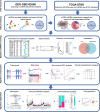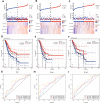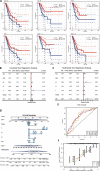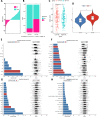Identification of memory B-cell-associated miRNA signature to establish a prognostic model in gastric adenocarcinoma
- PMID: 37735667
- PMCID: PMC10515266
- DOI: 10.1186/s12967-023-04366-2
Identification of memory B-cell-associated miRNA signature to establish a prognostic model in gastric adenocarcinoma
Abstract
Background: Memory B cells and microRNAs (miRNAs) play important roles in the progression of gastric adenocarcinoma (GAC), also known as stomach adenocarcinoma (STAD). However, few studies have investigated the use of memory B-cell-associated miRNAs in predicting the prognosis of STAD.
Methods: We identified the marker genes of memory B cells by single-cell RNA sequencing (scRNA-seq) and identified the miRNAs associated with memory B cells by constructing an mRNA‒miRNA coexpression network. Then, univariate Cox, random survival forest (RSF), and stepwise multiple Cox regression (StepCox) algorithms were used to identify memory B-cell-associated miRNAs that were significantly related to overall survival (OS). A prognostic risk model was constructed and validated using these miRNAs, and patients were divided into a low-risk group and a high-risk group. In addition, the differences in clinicopathological features, tumour microenvironment, immune blocking therapy, and sensitivity to anticancer drugs in the two groups were analysed.
Results: Four memory B-cell-associated miRNAs (hsa-mir-145, hsa-mir-125b-2, hsa-mir-100, hsa-mir-221) with significant correlations to OS were identified and used to construct a prognostic model. Time-dependent receiver operating characteristic (ROC) curve analysis confirmed the feasibility of the model. Kaplan‒Meier (K‒M) survival curve analysis showed that the prognosis was poor in the high-risk group. Comprehensive analysis showed that patients in the high-risk group had higher immune scores, matrix scores, and immune cell infiltration and a poor immune response. In terms of drug screening, we predicted eight drugs with higher sensitivity in the high-risk group, of which CGP-60474 was associated with the greatest sensitivity.
Conclusions: In summary, we identified memory B-cell-associated miRNA prognostic features and constructed a novel risk model for STAD based on scRNA-seq data and bulk RNA-seq data. Among patients in the high-risk group, STAD showed the highest sensitivity to CGP-60474. This study provides prognostic insights into individualized and precise treatment for STAD patients.
© 2023. BioMed Central Ltd., part of Springer Nature.
Conflict of interest statement
The authors declare that they have no competing interests.
Figures









Similar articles
-
Genome-wide analysis to identify a novel microRNA signature that predicts survival in patients with stomach adenocarcinoma.J Cancer. 2019 Oct 17;10(25):6298-6313. doi: 10.7150/jca.33250. eCollection 2019. J Cancer. 2019. PMID: 31772663 Free PMC article.
-
Angiogenesis-related lncRNAs predict the prognosis signature of stomach adenocarcinoma.BMC Cancer. 2021 Dec 7;21(1):1312. doi: 10.1186/s12885-021-08987-y. BMC Cancer. 2021. PMID: 34876056 Free PMC article.
-
The impact of the Hedgehog signal pathway on the tumor immune microenvironment of gastric adenocarcinoma by integrated analysis of scRNA-seq and RNA-seq datasets.Funct Integr Genomics. 2023 Aug 1;23(3):258. doi: 10.1007/s10142-023-01187-w. Funct Integr Genomics. 2023. PMID: 37526746
-
Identification and characterization of nucleotide metabolism and neuroendocrine regulation-associated modification patterns in stomach adenocarcinoma with auxiliary prognostic assessment and immunotherapy response prediction.Front Endocrinol (Lausanne). 2023 Jan 16;13:1076521. doi: 10.3389/fendo.2022.1076521. eCollection 2022. Front Endocrinol (Lausanne). 2023. PMID: 36726460 Free PMC article. Review.
-
Evaluation and application of tools for the identification of known microRNAs in plants.Appl Plant Sci. 2021 Apr 7;9(3):e11414. doi: 10.1002/aps3.11414. eCollection 2021 Mar. Appl Plant Sci. 2021. PMID: 33854848 Free PMC article. Review.
Cited by
-
The role of epigenetic regulation in pancreatic ductal adenocarcinoma progression and drug response: an integrative genomic and pharmacological prognostic prediction model.Front Pharmacol. 2024 Nov 21;15:1498031. doi: 10.3389/fphar.2024.1498031. eCollection 2024. Front Pharmacol. 2024. PMID: 39640482 Free PMC article.
-
Single-cell data revealed CD14-type and FCGR3A-type macrophages and relevant prognostic factors for predicting immunotherapy and prognosis in stomach adenocarcinoma.PeerJ. 2024 Jan 22;12:e16776. doi: 10.7717/peerj.16776. eCollection 2024. PeerJ. 2024. PMID: 38274323 Free PMC article.
-
Risk factors for mortality in patients with sepsis on extracorporeal membrane oxygenation and/or continuous renal replacement therapy: a retrospective cohort study based on MIMIC-IV database.Ren Fail. 2024 Dec;46(2):2436106. doi: 10.1080/0886022X.2024.2436106. Epub 2024 Dec 4. Ren Fail. 2024. PMID: 39632252 Free PMC article.
-
Advancing personalized, predictive, and preventive medicine in bladder cancer: a multi-omics and machine learning approach for novel prognostic modeling, immune profiling, and therapeutic target discovery.Front Immunol. 2025 Apr 22;16:1572034. doi: 10.3389/fimmu.2025.1572034. eCollection 2025. Front Immunol. 2025. PMID: 40330458 Free PMC article.
References
-
- Sung H, Ferlay J, Siegel RL, Laversanne M, Soerjomataram I, Jemal A, et al. Global cancer statistics 2020: GLOBOCAN estimates of Incidence and mortality Worldwide for 36 cancers in 185 countries. CA Cancer J Clin. 2021;71(3):209–249. - PubMed
-
- Ajani JA, Lee J, Sano T, Janjigian YY, Fan D, Song S. Gastric adenocarcinoma. Nat Rev Dis Primers. 2017;3:17036. - PubMed
-
- Chia NY, Tan P. Molecular classification of gastric cancer. Ann Oncol. 2016;27(5):763–769. - PubMed
-
- Gastric Cancer Association CA-CA Chinese expert consensus on perioperative treatment of locally advanced gastric cancer (2021 version) Zhonghua Wei Chang Wai Ke Za Zhi. 2021;24(9):741–748. - PubMed
Publication types
MeSH terms
Substances
LinkOut - more resources
Full Text Sources

